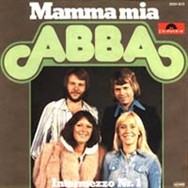In focus: The Making Of The ABBA Album
ABBA’s third album was the bridge that carried the group from Eurovision one-hit-wonders to a vital force in pop. In this feature we explore the journey that ended with worldwide smash hits such as ‘SOS’ and ‘Mamma Mia’.
Together or apart – or both?

What do you do with your time after you’ve enjoyed a Eurovision winner and worldwide breakthrough smash hit? That was largely the question that ABBA had to deal with in the summer of 1974, as they were winding down after the chaos of unexpected promotional activities that had followed their victory with ‘Waterloo’ at the Eurovision Song Contest in April. Write and record new songs, thereby building on the success you’ve achieved, you say? Certainly, but for Björn, Benny, Agnetha and Frida, that wasn’t necessarily the entire answer to the question. Although there was little doubt they would go on working as ABBA, there were also other projects on the agenda. Björn and Benny were still house producers at the Polar Music record company, and had several such assignments to attend to: believe it or not, but one of them was actually an album with Björn’s “old” group, the Hootenanny Singers. One would have thought that group would be dead and buried after ABBA’s overwhelming triumph, but at the time Björn actually envisioned a future where he could divide his attention between both groups.
 Benny also oversaw the recording of Frida’s second solo album, Frida ensam (“Frida Alone”), sessions for which would continue until the end of 1975. Agnetha, meanwhile, started sessions for her fifth album, Elva kvinnor i ett hus (“Eleven Women In One House”), which also wouldn’t be released until late 1975. Also, the ABBA members had to find some time for relaxation in the midst of all this behind-the-scenes acitivity. That meant the cancellation of a tour of Sweden’s so-called “folkparks”, much to the chagrin of the arrangers who were looking forward to a lucrative summer with the nation’s most popular band.
Benny also oversaw the recording of Frida’s second solo album, Frida ensam (“Frida Alone”), sessions for which would continue until the end of 1975. Agnetha, meanwhile, started sessions for her fifth album, Elva kvinnor i ett hus (“Eleven Women In One House”), which also wouldn’t be released until late 1975. Also, the ABBA members had to find some time for relaxation in the midst of all this behind-the-scenes acitivity. That meant the cancellation of a tour of Sweden’s so-called “folkparks”, much to the chagrin of the arrangers who were looking forward to a lucrative summer with the nation’s most popular band.

On August 22, 1974, work finally began on what was to become ABBA’s third album. On the two first recording days, basic backing tracks were completed for ‘So Long’, ‘Man In The Middle’ and ‘SOS’. Those three tracks, like most of the album, were committed to tape at Glen Studio, located in the basement of the house owned by producer and arranger Bruno Glenmark. Up until then, ABBA had mainly been recording at Metronome Studio, but when their talented and inventive sound engineer, Michael B. Tretow, left his employment at Metronome and moved on to Glen, ABBA followed him there. It was also easier for the group to block book Glen Studio for extended periods of time than it had been at Metronome Studio. The block booking was something that became increasingly important for them as their ambitions grew and more and more time was spent on recording each song.
Initially, the somewhat optimistic intention had been that the new album should be ready for release before Christmas 1974. However, although the completion of three backing tracks at the very start of the sessions was an encouraging sign, the more time ABBA spent on perfecting each recording, the more obvious it was that there was no chance that they could have an album ready within just a few months. Also, a tour of Europe was scheduled for the last two weeks of November, followed by a fortnight on the Scandinavian roads in January – not to mention promotional trips to various European countries as well as the United States. The album deadline was soon pushed back to the spring of 1975.
Part of ABBA’s new quest for perfection was that they were more prone to scrapping entire recordings, throwing away songs that they would previously have kept simply because they needed to get an album finished. During the sessions for this third album, titles such as ‘Rikky Rock’n’Roller’, ‘Terra del Fuego’ and ‘Crazy World’ were all left on the scrapheap, although the latter recording was later resurrected, polished up and issued as a single B-side. In other cases, such as ‘Bang-A-Boomerang’, a backing track had been completed when Björn and Benny decided that they needed to re-write parts of the actual tune. Thus, a completely new version of the song had to be recorded. There was also the case of a song like ‘Rock Me’, originally with lyrics entitled ‘Baby’ and featuring Agnetha as lead vocalist – when the song was finally released it was, of course, Björn who performed it.

The recording sessions for the new album were conducted at a somewhat troubled time for ABBA, at least as far as their career outside Scandinavia was concerned. It wasn’t necessarily going to be so easy to sustain the success they had achieved with ‘Waterloo’. Chart positions for their follow-up singles – ‘Honey, Honey’ and a remixed version of ‘Ring Ring’ – were largely discouraging. The group realized that they were the victims of The Curse Of Eurovision, dictating that you were entitled to one hit and then were expected to disappear off the face of the earth forever. “We felt that ‘they have decided that ABBA are something which we simply aren’t!’,” Björn recalled.


Big hits and great success
It wasn’t until the second half of 1975 that everything finally came together in a big way, for that was when the group finally released the two strongest LP tracks as singles. The first of them was the mind-blowingly brilliant ‘SOS’, featuring a characteristically plaintive lead vocal from Agnetha. ABBA had made promo clips for four of the songs off the album – ‘Mamma Mia’, ‘SOS’, ‘I Do, I Do, I Do, I Do, I Do’ and ‘Bang-A-Boomerang’ – and when these were shown on Australian television it was the start of an ABBA fever of incomprehensible proportions, with the group occupying the number one spot on the singles chart for 14 weeks in a row.
Indeed, it was only through the enthusiastic prompting of RCA, ABBA’s Australian record company, that ‘Mamma Mia’ was released as the fourth worldwide single off the ABBA album. It was a fortuitous decision, as this song alone accounted for 10 of the weeks the group spent at the top of the Australian charts, and in the UK – where ‘SOS’ had finally brought ABBA back in the Top Ten again – ‘Mamma Mia’ became the group’s first number one since ‘Waterloo’. The derision traditionally afforded former Eurovision winners was clearly not applicable on ABBA.
Although the group’s recordings had an identity particular to the four members from the moment they started working together, it was the ABBA album – particularly in knock-out pop tracks such as ‘SOS’ and ‘Mamma Mia’ – that made it clear that they had truly found their own voice, arriving at the famed “ABBA sound”. The recordings were crisp and clear, the vocals shimmered in multilayered harmony, and every last bit of the soundscape was filled with imaginative keyboard flourishes, guitar riffs or other sonic effects. Quite simply, ABBA was the transitionary album that brought the group from Swedish hopefuls to a significant force in current popular music. And, most importantly, the phenomenal success the songs from the LP brought them, meant that the ABBA album erased any lingering doubts as to where the four members would be concentrating their musical efforts over the next few years.

